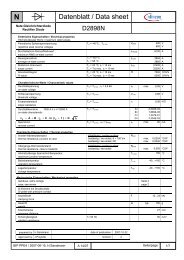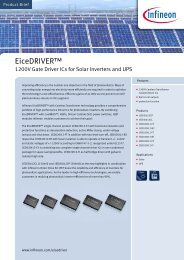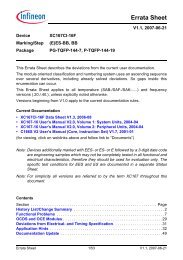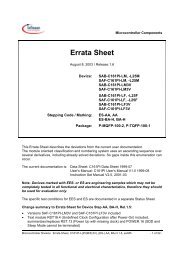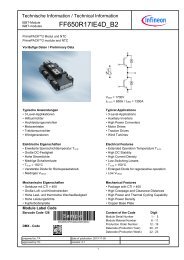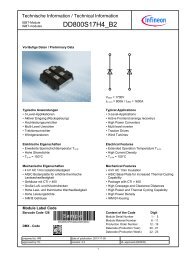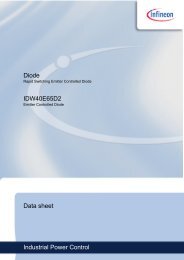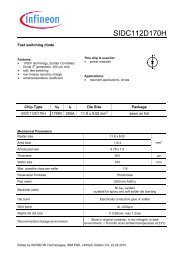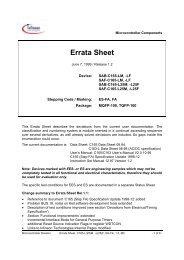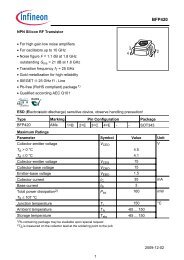Application Note CoolMOS™ CP - Infineon
Application Note CoolMOS™ CP - Infineon
Application Note CoolMOS™ CP - Infineon
You also want an ePaper? Increase the reach of your titles
YUMPU automatically turns print PDFs into web optimized ePapers that Google loves.
CoolMOS TM <strong>CP</strong><br />
- How to make most beneficial use of the latest<br />
generation of super junction technology devices<br />
3 Dynamic Switching Behavior of CoolMOS TM <strong>CP</strong><br />
MOSFET switching is governed first and foremost about<br />
resistances (gate input) and capacitances (gate to source<br />
Cgs, gate to drain Cgd, and source to drain Cds), see<br />
Figure 8. With the very fast switching speed of CoolMOS<br />
<strong>CP</strong>, secondary effects become as well important, such as<br />
the influence of source circuit inductance and drain to<br />
source output capacitance. Behaviors may be seen, which<br />
are not usually encountered with conventional MOSFETs.<br />
Understanding these behaviors and using them to<br />
advantage within safe limits in the application requires a<br />
deeper look into the MOSFET switching behavior. Turn-on<br />
behavior is usually strongly influenced by the application<br />
circuit and associated components, but turn-off behavior is<br />
usually controlled just by the MOSFET, so this is the mode<br />
which will be examined closely in this section.<br />
<strong>Note</strong> that for correlation with standard data sheet terms,<br />
Ciss = Cgs + Cgd, Crss = Cgd, and Coss = Cds + Cgd.<br />
Figure 8 Elements controlling MOS switching.<br />
3.1 Gate Controlled MOSFET Switching<br />
Considering the diagram of Figure 9, the gate controlled<br />
MOSFET turn-off occurs in three fairly discrete intervals,<br />
and the behavior and losses for each interval is described<br />
separately below:<br />
In the interval t1, the gate voltage is discharged to the<br />
current plateau level by the driver, with a time determined<br />
largely by Ciss, the gate input resistance RG, and the<br />
operating voltage levels for the gate drive and the plateau<br />
voltage determined by the MOSFET gfs and load current:<br />
⎛<br />
t1 = R G<br />
⋅C iss<br />
⋅ ln V − V ⎞<br />
GDrv G −Off<br />
⎜<br />
V Plat<br />
− V<br />
⎟<br />
⎝<br />
G −Off ⎠<br />
(1)<br />
In the interval t2, the MOSFET is acting like an integrating<br />
amplifier, and the gate current supplied through Rg is that<br />
needed to charge Cgd as VDS rises, even while full ID<br />
current flows:<br />
t2 = R G ⋅ C rss ⋅V DS<br />
V Plat<br />
− V G−Off<br />
Figure 9 Example of gate controlled turn-off<br />
switching.<br />
(2)<br />
During this gate controlled interval, where dVDS/dt is controlled by gate drive, the actual rate of change can be<br />
described by:<br />
dV DS<br />
dt<br />
= V Plat<br />
− V G−Off<br />
R G<br />
⋅ C Rss<br />
(3)<br />
In the final portion of turn-off, the gate drops below the plateau region, as RG discharges Ciss further, and ID falls<br />
following the MOSFET transfer function for ID as a function of VGS.<br />
⎛<br />
t3 = R G<br />
⋅ C iss<br />
⋅ ln V Plat<br />
− V G−Off<br />
⎞<br />
⎜<br />
⎝ V th<br />
− V<br />
⎟<br />
G−Off ⎠<br />
(4)<br />
9 of 32



